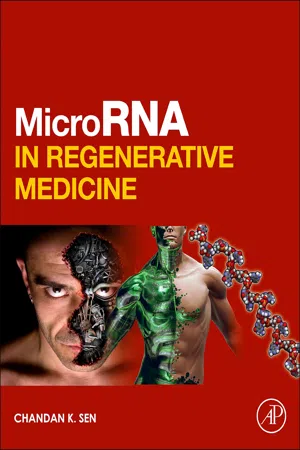3′UTR
the untranslated region at the 3′ end of eukaryotic messenger RNA, which is important in translation regulation.
Allogeneic cells
cells genetically different although belonging to or obtained from the same species, such as those obtained from one human for treatment of another human.
Antagomirs
chemically modified antisense oligonucleotides for silencing endogenous miRNAs. They are used for inhibiting miRNA–mRNA interactions.
Argonaute (Ago)
the catalytic components of the RNA-induced silencing complex (RISC); named after the Argonaute (Ago) phenotype of Arabidopsis mutants, which itself was named after its resemblance to argonautes. Ago creates 5′-phosphate and 3′-hydroxyl termini, leaving 2-nucleotide 3′ overhangs.
Dicer
a member of the RNase III family of ribonucleases; it cleaves dsRNAs into small interfering RNAs and pre-miRNAs, and mirtrons into miRNAs.
Differentiation
cellular progression to a more specialized type; the process of development that increases the level of organization or complexity of a cell or tissue, accompanied by a more specialized function.
Double-stranded RNA–binding domain (dsRBD)
a protein domain that binds to the A-form double-stranded RNA helix: proteins that contain a dsRBD function in RNA localization, editing, translational repression, and post-transcriptional gene silencing.
Drosha
an endoribonuclease in the RNase III family that cleaves pri-miRNAs into pre-miRNAs.
Exportin 5 (EXP5)
a pre-miRNA–specific export carrier that mediates nuclear export of pre-miRNAs to cytosol.
Functional tissue engineering
the study of the structure and function of living tissues, with the aim of recreating them in the laboratory. Such engineered tissues can be used to replace damaged body parts or to study complex biological problems in a controlled environment.
Hematopoietic stem cells
the precursors of mature blood cells that are defined by their ability to replace the bone marrow system following its obliteration (e.g., by gamma irradiation); these cells continue to produce mature blood cells.
Heterochromatin
highly condensed regions of the genome in which transcription is generally limited.
Human embryonic stem cell
a stem cell derived from the inner cell mass of a blastocyst; it can differentiate into several tissue types in culture.
Mesenchymal stem cells
also known as bone marrow stromal cells, rare cells mainly found in bone marrow that can give rise to a large number of tissue types such as bone, cartilage (the lining of joints), and fat and connective tissue (tissue that is between organs and structures in the body).
miRNA signature
the specific miRNA expression profile in a tissue/organ under a certain physiological or pathological condition.
miRNA∗
a miRNA duplex generated by the pre-miRNA processed by Dicer, containing the miRNA strand and the miRNA∗ strand, one of which is loaded into the RNA-induced silencing complex (RISC).
Mirtron
a miRNA generated from short spliced introns without Drosha-mediated cleavage.
Off-target effects
any detectible phenotypic change that is triggered by RNAi treatment, other than changes derived directly or indirectly from silencing of the targeted mRNA.
Paralog
a gene or protein with a highly similar sequence to another gene or protein that is encoded in the same genome.
Pluripotent stem cells
stem cells that can become all the cell types found in an implanted embryo, fetus, or developed organism, but not embryonic components of the trophoblast and placenta (these are usually called extra-embryonic).
Poly-cistronic transcription unit
a transcript that includes regions representing multiple, nonoverlapping gene products.
Precursor miRNAs (pre-miRNAs)
hairpin precursors of miRNAs formed by the cleavage of pri-miRNAs by Drosha and DCGR8.
Primary miRNAs (pri-miRNAs)
the initial transcriptional products of miRNA genes; they are generally more than 100 nucleotides long and may contain one or more miRNA stem loops that are processed by the miRNA biogenesis pathway.
Processing bodies (P-bodies)
regions within the cytoplasm of the eukaryotic cell consisting of many enzymes involved in mRNA turnover, including mRNA degradation and sequestration.
Regenerative medicine
clinical procedures that aim to repair damaged tissue or organs, most often by using tissue-engineered scaffolds and stem cells to replace cells and tissues damaged by aging and by disease. In some cases, medical devices are part of the therapeutic procedure.
RNA-induced silencing complex (RISC)
a group of proteins, including one of the Argonaute proteins, that induce target mRNA cleavage based on loaded small interfering RNA or miRNA guide strands.
RNase III-type protein
an endonuclease that cleaves double-stranded RNAs.
Scaffold
in the context of engineered tissue, a biomaterial that can be formed in the shape of tissue that needs to be replaced. The scaffold is typically impregnated (seeded) with a patient’s cells before implantation. It is designed to “dissolve” in several months as the cells grow on it.
Seed
a sequence of seven bases in a miRNA complementary to the mRNA target. This sequence is essential for the initial binding of the miRNA to most targets. See...
